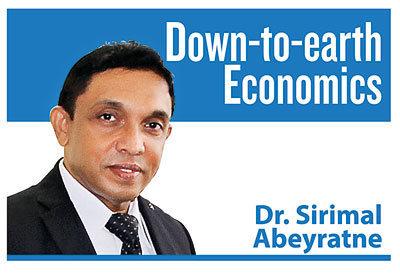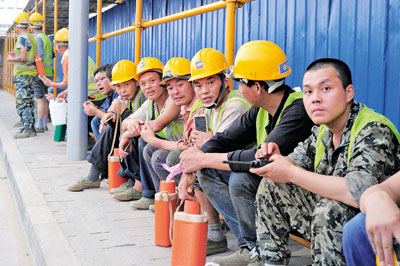Peculiarities of labour shortage in Sri Lanka
View(s):If “things did go right” since the end of the separatist war in 2009, Sri Lanka would soon be faced with a shortage of labour – more of “skilled” than “unskilled” labour, according to a study that I myself undertook for the ILO in 2011. Employment projections of the study were carried out by my colleague, Dr. Mahinda Pushpakumara, who came up with future employment to have reached eight million by 2015, and over nine million by 2020 with increased demand for skilled labour.
What went wrong?
The above study titled “Employment implications of the ‘‘Five – Hubs Strategy’’ of Sri Lanka” was a background paper for the country’s employment strategy 2012. However, “things did not go right” as outlined in the policy vision of the government.
An important aspect of this policy vision was to transform Sri Lanka into a “dynamic global hub” in the areas of shipping, aviation, commerce, energy and knowledge; in all five areas Sri Lanka had a long way to go with policy reforms. The key to achieve a global hub status was the ‘greater connectivity’ and ‘global competitiveness’ which required reforms.
Alas! It was just a vision, without a mission.
Today there are about eight million people reported as employed, unemployment rate is as low as 4.2 per cent; it is just about 360,000. In spite of economic backsliding in the areas of the “five hubs strategy” over the years, here we are now actually faced with a labour shortage – but, more of “unskilled” labour than “skilled” labour.
Let’s look at this current labour shortage, its economic implications, and the available policy options to address the issue.
Economic growth vs labour shortage
Rapid economic growth naturally results in both an increased demand for labour and a change in job composition. Basically, economic growth comes more from services and industry sectors than from agriculture. This means that growing labour demand is more for skilled labour than for unskilled labour; the country needs more professionals, managers, technicians and others alike than manual workers and subsistence farmers. The “Five-Hubs Strategy” would have created demand for such skilled labour.
In fast-growing economies, as services and industry sectors grow more rapidly than agriculture sectors, the country has to invest and prepare a “skilled labour force” well in advance.
In fact, evidence suggests that, except for general education, Sri Lanka has poorly invested in this particular area. Then you find, as some called it, the “middle-income trap” – a situation where the country has exhausted its development phase based on “cheap labour” and awaiting the next phase based on “skilled labour.”
Peculiar shortage
According to the comments from the business sector, one of the biggest issues that Sri Lanka is faced with today is finding workers for their business. Even after offering Rs. 30,000 – 40,000 a monthly salary with other benefits such as subsidised meals, transport and, medical facilities it is hard to find workers. Even if a few workers are found and recruited, you find them no more after the first month’s wage.
Now there are hundreds of workers from China and India, while the opportunities are opening up to recruit labour from Nepal and Myanmar as well. Another comment I heard was that they are more hard-working and more productive than Sri Lankan workers!
One idea is that the current labour shortage is just a “Colombo scenario” as businesses that go out of Colombo do not face a problem as such. Despite that, it is undeniable that a significant portion of Sri Lanka’s workforce is in “wrong jobs” in keeping the unemployment rate low.
Too many, producing too little
About two million people or nearly one-fourth of the employed, are still jammed in the agriculture sector, which contributes just seven per cent to GDP. The major problem of the Sri Lankan agriculture sector is that “too many people there produce too little.” As a result, income in the agriculture sector continued to remain too low, constraining their bargaining power in the market as well.

File picture of Chinese workers at a construction site in Sri Lanka.
If you can separate the plantations from agriculture sector, the problem I reveal would be even more acute than what is stated here.
How can we encourage labour outflows from the agriculture sector? It is basically the expansion of services and industry sectors on the one hand, and the development of the urban sector and urban settlements on the other hand.
By the way, you might be able to recognize some of the rural development activities too which have been aimed at nailing down people to rural agriculture and rural poverty!
Hostile home, go abroad
More than a million people from the Sri Lankan labour force are in the Middle East and other countries as migrant workers. There is no accurate count of the migrant labour force, but according to gross estimates, it is assumed to be in the range of 1.5 – 2 million people. Of course, if you count the amount of foreign exchange that they remit to the country, you may like to keep silent about it. It is about US$7 billion or about two-third of our export income.
In fact, over time skilled labour migration has increased. During the past 20 years the share of “skilled” labour category has doubled exceeding 40 per cent of the total number of migrant workers. It is worrying to think that skilled labour has no space in a growing economy of a middle-income category.
From an economic point of view, many would choose to migrate for work firstly because the home economy is not capable of providing them opportunities to work; secondly, even if there are opportunities, the reward (defined beyond the monetary remuneration) is too little and uncertain. Anyway, it is a “politically correct” trend because it keeps the Sri Lankan unemployment rate down.
Cosy state jobs
Another rational choice for employment is the government sector. I do not blame them; there is job security, life time pensions, less work, many holidays, work flexibility, and on top of all that, there is less accountability. At present there are about 1.4 million government employees, but 10 years ago, it was about 1 million.
When the government sector expands, it inflates economic growth as well, because the output of the government sector services is estimated in terms of not output, but inputs. The input is how much is spent (from tax money) to accommodate a government employee. Therefore, even without any addition to real output, an increased public sector inflates GDP!
Over one million people, mostly the youth, are also said to be idling in the tuk-tuks. Perhaps, you might wonder why there are too many tuk-tuks in the city. It is primarily because of the problem of public transport. When there are more advanced and more disciplined transport modes, in fact, the tuk-tuk culture is bound to shrink.
By the way, it is not difficult for an average family to afford to buy a tuk-tuk; some parents seem to be proud of buying one for their son, who just dropped out from the school or came to adulthood. What they don’t realise is that with this decision they just ruined the entire lifespan of the child who will not acquire any skills or work ethics thereafter.
Be prepared
When we look at the current issue of labour shortage, it is really a matter of inadequate economic growth based on the expansion of services and industry sectors.
Aspirational gaps play a role, but the incentive system is important for people to enter into productive and decent work. It is the rapid growth that attracts labour from less-productive and less-rewarding sectors to modern services and industry sectors.
The time is approaching when Sri Lanka will also have to face up to skilled labour demand as well. The country has to prepare for that: Invest more in human resource development and set up mechanisms to accommodate labour from abroad. Economic progress in many countries in the Asia Pacific and the Middle East regions has not been constrained by any labour shortage. (The writer is Professor of Economics at the University of Colombo)


